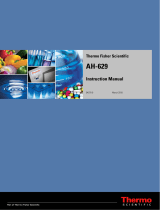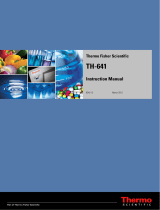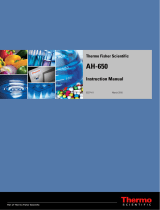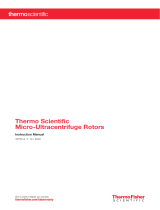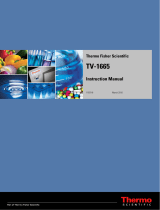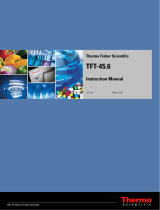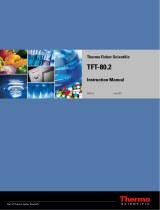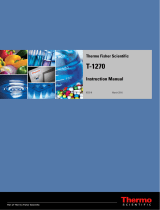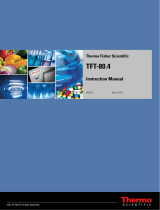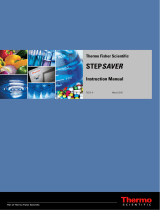Page is loading ...

Thermo Scientific
SureSpin 632 (17 mL)
SureSpin 632 (38.5 mL)
Ultracentrifuge Rotors
Instructions for Use
50153788-c • 05 / 2020
Visit us online to register your warranty:
thermofisher.com/labwarranty

Thermo Scientific SureSpin 632 Ultracentrifuge Rotor
2
Table of Contents
Preface . . . . . . . . . . . . . . . . . . . . . . . . . . . . . . . . . . 4
Intended Use . . . . . . . . . . . . . . . . . . . . . . . . . . . . . . . . 4
Items Supplied . . . . . . . . . . . . . . . . . . . . . . . . . . . . . . 5
SureSpin 632 (17 mL) Rotor . . . . . . . . . . . . . . . . . . . . . . .5
SureSpin 632 (38.5 mL) Rotor . . . . . . . . . . . . . . . . . . . . . .5
Signal Words and Colors . . . . . . . . . . . . . . . . . . . . . . 6
Safety Instructions . . . . . . . . . . . . . . . . . . . . . . . . . . . 6
Symbols used on the Rotor . . . . . . . . . . . . . . . . . . . . 8
Symbols used in the Manual . . . . . . . . . . . . . . . . . . . 8
I. Technical Specifications . . . . . . . . . . . . . . . . . . 9
II. Operation . . . . . . . . . . . . . . . . . . . . . . . . . . . . . 11
1. Prerun Safety Checks . . . . . . . . . . . . . . . . . . . . . 11
2. Bucket Use . . . . . . . . . . . . . . . . . . . . . . . . . . . . . . 12
3. Maximum Loading . . . . . . . . . . . . . . . . . . . . . . . . 13
4. Critical Speed . . . . . . . . . . . . . . . . . . . . . . . . . . . . 13
5. Rotor Precool . . . . . . . . . . . . . . . . . . . . . . . . . . . . 14
6. Chemical Compatibility . . . . . . . . . . . . . . . . . . . . 14
7. Relative Centrifugal Force (RCF) Determination
. . . . . . . . . . . . . . . . . . . . . . . . . . . . . . . . . . . . . . . . . . 14
8. Calculation of Sedimentation Times in Aqueous
(Non-Gradient) Solutions . . . . . . . . . . . . . . . . . . . . . 20
9. Calculation of Sedimentation Times in Gradient
Solutions . . . . . . . . . . . . . . . . . . . . . . . . . . . . . . . . . . 21
10. Rotor Installation . . . . . . . . . . . . . . . . . . . . . . . . 21
11. Tube Filling and Bucket Loading . . . . . . . . . . . 22
12. Installing Buckets and Performing a Run . . . . 26
13. Rotor Log . . . . . . . . . . . . . . . . . . . . . . . . . . . . . . 27

Thermo Scientific SureSpin 632 Ultracentrifuge Rotor
3
III. Maintenance and Care . . . . . . . . . . . . . . . . . 28
1. Cleaning Intervals . . . . . . . . . . . . . . . . . . . . . . . . 28
2. Basics . . . . . . . . . . . . . . . . . . . . . . . . . . . . . . . . . . 28
Rotors and Accessories Inspection . . . . . . . . . . . . . . . . .29
Speed Disk Decal Replacement . . . . . . . . . . . . . . . . . . . .29
3. Cleaning . . . . . . . . . . . . . . . . . . . . . . . . . . . . . . . . 30
4. Disinfection . . . . . . . . . . . . . . . . . . . . . . . . . . . . . 31
5. Decontamination . . . . . . . . . . . . . . . . . . . . . . . . . 32
6. Autoclaving . . . . . . . . . . . . . . . . . . . . . . . . . . . . . . 33
7. Storage . . . . . . . . . . . . . . . . . . . . . . . . . . . . . . . . . 34
8. Shipping . . . . . . . . . . . . . . . . . . . . . . . . . . . . . . . . 34
9. Disposal . . . . . . . . . . . . . . . . . . . . . . . . . . . . . . . . 34
Chemical Compatibility Chart . . . . . . . . . . . . . . 35
Index . . . . . . . . . . . . . . . . . . . . . . . . . . . . . . . . . . . 48
Table of Figures
Figure 1 – Cross section showing Rotor Radii . . . . . . . . .15
Figure 2 – Rotor Balancing . . . . . . . . . . . . . . . . . . . . . . . .22
Figure 3 – Cap and Bucket Assembly . . . . . . . . . . . . . . .24
Figure 4 – How to tighten the Bucket Caps . . . . . . . . . . .25
Figure 5 – Orientation of Bucket Cap Handle
with Numbers. . . . . . . . . . . . . . . . . . . . . . . . . . . . . . . . . .26
Figure 6 – Sample Rotor Log Sheet . . . . . . . . . . . . . . . . .27
Table of Tables
Table 1 – Cross section showing Rotor Radii . . . . . . . . .15
Table 2 – RCF Values and K Factor for 17 mL Buckets . .17
Table 3 – RCF Values and K Factor for 38.5 mL Buckets 19

Thermo Scientific SureSpin 632 Ultracentrifuge Rotor
4
Preface
Before using the centrifuge, read through this instruction manual carefully and
follow the instructions.
Not following the instructions and safety information in this instruction manual will
result in the expiration of the sellers warranty.
Intended Use
This rotor is only to be used for research to separate substance mixtures of
different densities. This rotor is not intended to be used in diagnostic procedures.
This rotor has to be operated by trained personnel only.
This rotor is intended to be operated in an ultracentrifuge of the Sorvall WX or
WX+ series.

Thermo Scientific SureSpin 632 Ultracentrifuge Rotor
5
Items Supplied
The Thermo Scientific™ SureSpin™ 632 Rotor is supplied with accessories either
for 17 mL or 38.5 mL.
If any parts are missing, please contact the nearest Thermo Fisher Scientific
representative.
SureSpin 632 (17 mL) Rotor
Article No. Item Quantity
75003031 Thermo Scientific SureSpin 632 Ultracentrifuge
Rotor (17 mL) including Buckets, Rack, Rotor
Stand, O-rings, O-ring Grease, Lubricant for
Bucket Threads, Speed Disk (32 000 rpm), Rotor
Log Book, Instruction Manual
1 set
SureSpin 632 (38.5 mL) Rotor
Article No. Item Quantity
75003032 Thermo Scientific SureSpin 632 Ultracentrifuge
Rotor (38.5 mL) including Buckets, Rack, Rotor
Stand, O-rings, O-ring Grease, Lubricant for
Bucket Threads, Speed Disk (32 000 rpm), Rotor
Log Book, Instruction Manual
1 set

Thermo Scientific SureSpin 632 Ultracentrifuge Rotor
6
Signal Words and Colors
WARNING Indicates a hazardous situation that, if not avoided, could
result in death or serious injury.
CAUTION Inidicates a hazardous situation that, if not avoided, could
result in minor or moderate injury.
NOTICE Indicates information considered important, but not hazard-
related (e.g. messages relating to property damage).
Safety Instructions
WARNING
Observe the safety instructions. Not following these instructions can cause
damage.
The rotor is to be used for its intended use only. Improper use can cause
damages, contamination, and injuries with fatal consequences.
The rotor must be operated by trained personnel only.
Keep a safety zone of minimum 30 cm around the centrifuge. Persons and
hazardous substances must be kept out of this safety zone while centrifuging.
Preparation
WARNING
It is the obligation of the operator to make sure, that protective clothing is used.
Mind the “Laboratory Biosafety Manual” of the World Health Organization (WHO)
and the regulations in your country.

Thermo Scientific SureSpin 632 Ultracentrifuge Rotor
7
NOTICE
Use only with a rotor that has been properly installed. Follow the instructions
in section “Prerun Safety Checks” on page 11.
Do not use a rotor or accessories that show any signs of corrosion or cracks.
Contact customer service for further advice or inspections.
Use only with a rotor that has been properly loaded.
Never overload the rotor.
Always balance the samples.
Use only rotors and accessories approved by ThermoFisherScientific.
Make sure the rotor is locked properly into place before operating the
centrifuge.
Do not use a damaged rotor. Replace the rotor, if it was dropped.
Hazardous Substances
WARNING
Especially when working with corrosive samples (salt solutions, acids, bases),
the accessory parts and vessel have to be cleaned thoroughly.
Do not centrifuge explosive or flammable materials or substances.
Do not centrifuge toxic or radioactive materials or any pathogenic micro-
organisms without suitable safety precautions.
If any hazardous materials are centrifugated, mind the “Laboratory Biosafety
Manual” of the World Health Organization (WHO) and any local regulations.
When centrifuging microbiological samples from the Risk Group II (according
to the “Laboratory Biosafety Manual” of the World Health Organization (WHO)),
aerosol-tight biological seals have to be used. Look on the internet page of the
World Health Organization (www.who.int) for the “Laboratory Biosafety Manual”.
For materials in a higher risk group, extra safety measures have to be taken.
If toxins or pathogenic substances have contaminated the centrifuge or its
parts, appropriate disinfection measures have to be taken (“Disinfection” on
page 31).
Extreme care should be taken with highly corrosive substances which can
cause damage and impair the mechanical stability of the rotor. These should
only be centrifuged in fully sealed tubes.
In case of rotor failure the centrifuge can be damaged. The coolant can
escape. Ventilate the room well and leave it. Inform customer service.
If a hazardous situation occurs, turn off the power supply to the centrifuge and
leave the area immediately.

Thermo Scientific SureSpin 632 Ultracentrifuge Rotor
8
Symbols used on the Rotor
The CE mark states that this product is meeting all
requirements for the European Economic Area.
This symbol refers to information on hazards, described within
the manual.
Symbols used in the Manual
This symbol refers to general hazards.
This symbol refers to biological hazards.
Observe the information contained in the instruction manual to
keep yourself and your environment safe.

Thermo Scientific SureSpin 632 Ultracentrifuge Rotor
9
I. Technical Specifications
Thermo Scientific SureSpin 632 Rotor Body
Maximum Speed nmax 32 000 rpm
Critical Speed 1 100 rpm
Maximum Cycle Number 1 200
Number of Buckets 6
Weight (without Buckets) 6 382 g
Buckets for 38.5 mL Tubes
Maximum RCF Value at nmax
at rminimum (7.46 cm)
at raverage (11.91 cm)
at rmaximum (16.36 cm)
85 404 x g
136 349 x g
187 295 x g
K-Factor at nmax 194
Tube Volume 38.5 mL
Tube Diameter 25 mm
Tube Length 89 mm
Maximum Cycle Number 1 200
Compartment Mass
(incl. complete bucket, tube, sample) 190.5 g
Maximum Kinetic Energy 223 kJ
Weight (Rotor Body with empty Buckets) 7 210 g
Buckets for 17 mL Tubes
Maximum RCF Value at nmax
at rminimum (6.85 cm)
at raverage (11.80 cm)
at rmaximum (16.75 cm)
78 421 x g
135 090 x g
191 759 x g
K-Factor at nmax 221
Tube Volume 17 mL
Tube Diameter 16 mm
Tube Length 102 mm
Maximum Cycle Number 1 200
Compartment Mass
(incl. complete bucket, tube, sample) 183 g
Maximum Kinetic Energy 211 kJ
Weight (Rotor Body with empty Buckets) 7 342 g

Thermo Scientific SureSpin 632 Ultracentrifuge Rotor
10
Accessories
Article No. Item
75003036 17 mL Bucket set,
incl. Buckets, Rack, O-Rings (17 mL) (set of 6) O-ring Grease
and Lubricant for Bucket Threads
75003037 38.5 mL Bucket set,
incl. Buckets, Rack, O-Rings (38.5 mL) (set of 6) O-ring Grease
and Lubricant for Bucket Threads
75003038 O-Rings (38.5 mL) (set of 6) and O-ring Grease
75003039 O-Rings (17 mL) (set of 6) and O-ring Grease
51360 Speed Disk (32 000 rpm)
52240 Rack
52384 Rotor Log Book
20048993 Rotor Stand
76003500 O-Ring Grease
75003786 Lubricant for Bucket Threads

Thermo Scientific SureSpin 632 Ultracentrifuge Rotor
11
II. Operation
This chapter contains the information necessary to prepare the rotor for operation
and includes important safety information.
1. Prerun Safety Checks
CAUTION Every part of the rotor must be clean and must be carefully
inspected before every run. If there is any sign of corrosion
or cracking, the rotor should not be used.
Failure to properly maintain your rotor can cause rotor
failure with subsequent damage to your centrifuge
including the sample.
To ensure safe performance of the rotor, before every run you should:
a. read and observe the „Precautions“ on page 6.
b. make sure that there are no burrs or scratches on the bucket, bucket
seats, or bucket pins.
c. check the centrifuge drive chamber, drive spindle, and mounting surface
of the rotor to be sure that they are clean and free of scratches or burrs.
d. inspect the bucket cap O-rings for cracks, tears, or abrasions; replace
if necessary.
e. make sure that the numbers on the bucket cap, bucket, and rotor
compartment match, and that opposing loads are balanced.
f. make sure each bucket cap is correctly installed. Gently tighten each
bucket cap by hand until they stop turning (Figure 5 on page 26).
g. after placement in the rotor, move each bucket slightly to ensure that
they pivot freely on their pins. When properly installed, the tops of all six
buckets will be at the same height.
CAUTION Make sure that the caps are closed completely. Incompletely closed
caps prevent the complete swing out of the buckets. An incomplete swing out of
the buckets can cause imbalance and damage the rotor and the centrifuge.

Thermo Scientific SureSpin 632 Ultracentrifuge Rotor
12
h. check the chemical compatibility of all materials used (“Chemical
Compatibility Chart” on page 35).
i. be sure that the proper environment has been selected for operation; for
example, controlled ventilation or isolation, if required.
j. check the top speed capability of the tube being used.
CAUTION Be sure to do a test run for the desired application to check the top
speed capability of the tubes being used.
2. Bucket Use
The bucket and cap assemblies are weighed, balanced, and supplied as a set of
6 that, for warranty requirements, shall not be mixed with buckets or caps from
other sets. For identification, all buckets in a specific set are marked with the
same weight, and each bucket and corresponding cap are numbered with rotor
compartment position (1 through 6).
If a bucket or cap is damaged so that it must be removed from service, the entire
set must be removed from service. If you question whether or not a rotor or bucket
set should be used, contact Thermo Fisher Scientific authorized service or your
local representative for Thermo Fisher Scientific products.
When a rotor body or a bucket set is removed from service at the end of their
lifetime it is possible to use the remaining rotor body or bucket set with a new
replacement until they reach the end of their service lifetime.

Thermo Scientific SureSpin 632 Ultracentrifuge Rotor
13
3. Maximum Loading
The rotor is designed to run with his maximum load at maximum speed. The safety
system of the centrifuge requires that the rotor is not overloaded.
The rotor is designed to work with substance mixtures with a density of up to
1.2g/mL. Maximum load includes the bucket, bucket cap, specimen and tube
for each of the six compartments of the rotor. If the admissible maximum load is
exceeded the following steps need to be taken:
Reduce the fill level.
Reduce the speed.
Use the following formula:
nadm = admissible maximum application speed
nmax = maximum rated speed
wmax = maximum rated load
wapp = applied load
CAUTION This formula does not apply when using gradients that can precipitate.
4. Critical Speed
CAUTION Continued operation at the critical speed will have a
detrimental effect on centrifuge component life.
The critical speed is that speed at which any rotor imbalance will produce a
driving frequency equal to the resonant frequency of the rotating system (rotor and
centrifuge drive). At this speed, the rotor may produce large amplitude vibrations
which can be felt in the instrument frame. Mass imbalance will contribute to
increased vibration intensity at the critical speed. Operation at critical speed
(“Technical Specifications” on page 9) has a negative effect on centrifuge
component life and should be avoided.

Thermo Scientific SureSpin 632 Ultracentrifuge Rotor
14
5. Rotor Precool
CAUTION Do not precool the rotor at critical speed.
If samples are routinely processed around 4 °C or below, the rotor can be stored
in a refrigerator or a cold room. If this is not possible, the rotor may be able to be
precooled in an ultracentrifuge. Refer to the individual Ultracentrifuge Instruction
Manual for precooling directions.
6. Chemical Compatibility
The critical components of the rotor to come in contact with solution are: rotor
body (titanium), rotor buckets (titanium), bucket caps (anodized aluminum),
O-rings (Viton), and tubes (polyallomer supplied, other tube materials vary).
The chemical compatibility of rotor elements and accessory materials is given in
„Chemical Compatibility Chart“ on page 35. Because no organized chemical
resistance data exists for materials under the stress of centrifugation, this data
is intended to be used only as a guide. Thermo Fisher Scientific recommends
pretesting of sample lots when in doubt.
7. Relative Centrifugal Force (RCF)
Determination
The relative centrifugal force (RCF) is given as a multiple of the force of gravity
(g). It is a unitless numerical value which is used to compare the separation or
sedimentation capacity of various centrifuges, since it is independent of the type
of device. Only the centrifuging radius and the speed are used for calculation:
RCF = 11.18 x x r
r = radius in cm from the centerline of the rotor to the point in the tube where RCF
value is required
n = rotational speed in rpm

Thermo Scientific SureSpin 632 Ultracentrifuge Rotor
15
The maximum RCF value is related to the maximum radius of the bucket cavity and
doesn’t take the thickness of the tube into consideration.
Figure 1 on page 15 shows the minimum, average, and maximum radii. Table
1 on page 15 gives the RCF value at each radius at speeds from 5 000 rpm to
32 000 rpm (in increments of 500 rpm). The RCF value at any other given speed
or radius can be calculated by using the above formula.
Figure 1
r
maximum
raverage
rminimum
– Cross section showing Rotor Radii
17 mL 38.5 mL
rmaximum 16.75 cm 16.36 cm
raverage 11.80 cm 11.91 cm
rminimum 6.85 cm 7.46 cm
Table 1 – Cross section showing Rotor Radii

Thermo Scientific SureSpin 632 Ultracentrifuge Rotor
16
17 mL Buckets
Speed (rpm)
RCF
K Factor
rmaximum
16.75 cm
raverage
11.80 cm
rminimum
6.85 cm
5 000 4682 3298 1915 9049
5 500 5665 3991 2317 7478
6 000 6742 4749 2757 6284
6 500 7912 5574 3236 5354
7 000 9176 6464 3753 4617
7 500 10534 7421 4308 4022
8 000 11985 8443 4901 3535
8 500 13530 9532 5533 3131
9 000 15168 10686 6203 2793
9 500 16901 11906 6912 2507
10 000 18727 13192 7658 2262
10 500 20646 14545 8443 2052
11 000 22659 15963 9267 1870
11 500 24766 17447 10128 1711
12 000 26966 18997 11028 1571
12 500 29260 20613 11966 1448
13 000 31648 22295 12943 1339
13 500 34129 24043 13957 1241
14 000 36704 25857 15010 1154
14 500 39372 27737 16102 1076
15 000 42135 29683 17231 1005
15 500 44990 31695 18399 942
16 000 47940 33773 19605 884
16 500 50983 35916 20850 831
17 000 54120 38126 22132 783
17 500 57350 40402 23454 739
18 000 60674 42743 24813 698
18 500 64091 45151 26211 661
19 000 67603 47625 27646 627
19 500 71208 50164 29121 595
20 000 74906 52770 30633 566

Thermo Scientific SureSpin 632 Ultracentrifuge Rotor
17
17 mL Buckets
Speed (rpm)
RCF
K Factor
rmaximum
16.75 cm
raverage
11.80 cm
rminimum
6.85 cm
20 500 78698 55441 32184 538
21 000 82584 58178 33773 513
21 500 86563 60982 35400 489
22 000 90636 63851 37066 467
22 500 94803 66787 38770 447
23 000 99063 69788 40512 428
23 500 103417 72855 42293 410
24 000 107865 75988 44112 393
24 500 112406 79187 45969 377
25 000 117041 82453 47864 362
25 500 121769 85784 49798 348
26 000 126591 89181 51770 335
26 500 131507 92644 53780 322
27 000 136516 96173 55829 310
27 500 141619 99768 57916 299
28 000 146816 103428 60041 289
28 500 152106 107155 62205 279
29 000 157490 110948 64406 269
29 500 162967 114807 66646 260
30 000 168539 118732 68925 251
30 500 174203 122722 71241 243
31 000 179962 126779 73596 235
31 500 185814 130902 75989 228
32 000 191759 135090 78421 221
Table 2 – RCF Values and K Factor for 17 mL Buckets
38.5 mL Buckets
Speed
RCF
K Factor
rmaximum
16.36 cm
raverage
11.91 cm
rminimum
7.46 cm
5 000 4573 3329 2085 7947

Thermo Scientific SureSpin 632 Ultracentrifuge Rotor
18
38.5 mL Buckets
Speed
RCF
K Factor
rmaximum
16.36 cm
raverage
11.91 cm
rminimum
7.46 cm
5 500 5533 4028 2523 6568
6 000 6585 4794 3003 5519
6 500 7728 5626 3524 4702
7 000 8962 6525 4087 4055
7 500 10288 7490 4691 3532
8 000 11706 8522 5338 3104
8 500 13215 9620 6026 2750
9 000 14815 10785 6756 2453
9 500 16507 12017 7527 2201
10 000 18290 13315 8340 1987
10 500 20165 14680 9195 1802
11 000 22131 16112 10092 1642
11 500 24189 17610 11030 1502
12 000 26338 19174 12010 1380
12 500 28579 20805 13032 1272
13 000 30911 22503 14095 1176
13 500 33334 24267 15200 1090
14 000 35849 26098 16347 1014
14 500 38456 27996 17535 945
15 000 41154 29960 18766 883
15 500 43943 31990 20038 827
16 000 46824 34087 21351 776
16 500 49796 36251 22706 730
17 000 52859 38481 24103 687
17 500 56015 40778 25542 649
18 000 59261 43142 27023 613
18 500 62599 45572 28545 581
19 000 66029 48069 30108 550
19 500 69550 50632 31714 522
20 000 73162 53262 33361 497
20 500 76866 55958 35050 473

Thermo Scientific SureSpin 632 Ultracentrifuge Rotor
19
38.5 mL Buckets
Speed
RCF
K Factor
rmaximum
16.36 cm
raverage
11.91 cm
rminimum
7.46 cm
21 000 80661 58721 36781 451
21 500 84548 61550 38553 430
22 000 88526 64446 40367 410
22 500 92596 67409 42223 392
23 000 96757 70438 44120 376
23 500 101009 73534 46059 360
24 000 105353 76697 48040 345
24 500 109789 79926 50063 331
25 000 114316 83221 52127 318
25 500 118934 86583 54233 306
26 000 123644 90012 56380 294
26 500 128445 93507 58570 283
27 000 133338 97069 60801 273
27 500 138322 100698 63073 263
28 000 143397 104393 65388 253
28 500 148564 108154 67744 245
29 000 153823 111982 70142 236
29 500 159173 115877 72581 228
30 000 164614 119838 75063 221
30 500 170147 123866 77585 214
31 000 175772 127961 80150 207
31 500 181487 132122 82756 200
32 000 187295 136349 85404 194
Table 3 – RCF Values and K Factor for 38.5 mL Buckets

Thermo Scientific SureSpin 632 Ultracentrifuge Rotor
20
8. Calculation of Sedimentation Times in
Aqueous (Non-Gradient) Solutions
The time required to sediment a particle in water at 20 °C through the maximum
rotor path length (that is, the distance between rminimum and rmaximum) can be
estimated using the equation:
where:
t = sedimentation time in hours
K = the clearing factor for the rotor (defined below).
S20, w = the sedimentation coefficient for the particle of interest in water at
20°C as expressed in Svedbergs*
The clearing, or K factor, is defined by the equation:
Where rmaximum and rminimum are the maximum and minimum rotor radii,
respectively, and rotor speed is expressed in rpm.
K factors for the rotor at speeds from 5 000 rpm to 32 000 rpm have been listed in
Table 2 on page 17 and Table 3 on page 19.
Example: The rotor has a K factor of 255 at the maximum speed when 17 mL
buckets are used. If the particles to be sedimented have a sedimentation
coefficient of 40 S, the estimated run time required at maximum speed will be:
t = = 6.4 hours = 6 hours, 24 minutes
* The sedimentation coecient (S) in seconds, for a particle in a centrifugal field is defined
by the equation S = (dx/dt) [1/(ω2x)]; where dx/dt = sedimentation velocity of the particle
in cm/s; ω = rotor speed in rad/s; and x = the distance of the particle from the axis of
rotation in centimeters. Conventionally, experimentally determined values of sedimentation
coecients are multiplied by 1013 to convert them to Svedberg units (S), so a particle with
an experimentally determined sedimentation coecient of 10-11 seconds is usually referred
to in the literature as a “100 S particle.” The value determined for the sedimentation
coecient is dependent on the density and viscosity of the solution in which centrifugation
is performed, values are usually reported for the standard conditions of infinite dilution in
water at 20 °C, and designated S20, w.
/
